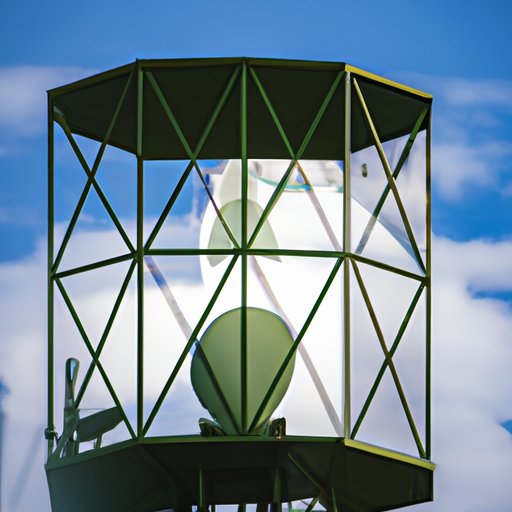
An Overview of Radar Technology
Radar technology is one of the most important tools used by scientists and engineers to gather data about the environment around us. But what is radar and how does it work? Radar stands for Radio Detection and Ranging, and it is a type of technology that uses radio waves to detect objects and measure their distance, speed, and direction. It has a wide range of applications, from military surveillance to weather forecasting.
The history of radar can be traced back to the early 20th century, when the first experiments were conducted using radio waves to detect ships. Since then, advances in radar technology have made it possible to detect aircraft, track storms, and even detect objects in outer space. Today, radar is used in a variety of industries, including military, aviation, weather forecasting, and more.
How Radar Works: A Step-by-Step Guide
Radar systems work by transmitting radio waves and then detecting the reflected signals. The basic components of a radar system include a transmitter, receiver, and signal processor. Here’s a closer look at how each of these components works:
Transmitter: The transmitter is the component that sends out the radio waves. These waves travel through the air until they reach an object, such as an airplane or a storm cloud. When the waves hit the object, some of them are reflected back towards the radar system.
Receiver: The receiver is the component that detects the reflected radio waves. It measures the strength of the signal, which can then be used to calculate the distance and direction of the object.
Signal Processor: The signal processor is the component that interprets the signal data and displays the results on a screen. The processor can also be used to filter out noise and interference, making it easier to identify objects of interest.

Exploring the Physics Behind Radar
In order to understand how radar works, it’s important to explore the physics behind it. There are two key concepts that are essential to understanding radar: radio waves and reflection, and the Doppler effect.
Radio Waves and Reflection: Radar systems use radio waves to detect objects. When a radio wave hits an object, some of the energy is reflected back to the radar system. The strength of the reflected signal depends on the size and shape of the object, as well as its distance from the radar system.
Doppler Effect: The Doppler effect is a phenomenon that occurs when a moving object reflects a radio wave. The frequency of the reflected radio wave is shifted up or down depending on whether the object is moving away from or towards the radar system. This shift in frequency can be used to calculate the speed of the object.

Radar Technology and Its Uses in the Modern World
Radar technology has a wide range of uses in the modern world. Here are just a few of the ways that radar is used:
Military: Radar is used extensively in the military for surveillance and target tracking. Radar systems can detect aircraft, ships, missiles, and other targets at long ranges, allowing the military to track enemy movements and respond quickly to threats.
Aviation: Radar is also used extensively in aviation. Radar systems are used to monitor air traffic, providing pilots with valuable information about nearby aircraft and helping to prevent collisions.
Weather Forecasting: Radar is also used in weather forecasting. Radar systems can detect rain, snow, and other forms of precipitation, allowing meteorologists to predict the weather more accurately.
The Components of a Radar System
Radar systems consist of several different components, each of which plays an important role in the functioning of the system. Here’s a look at the components of a typical radar system:
Antenna: The antenna is the component that transmits and receives the radio waves. It is usually mounted on a tower or other structure and is pointed in the direction of the target.
Transmitter: The transmitter is the component that generates the radio waves. It is usually housed inside the antenna and consists of a power supply, oscillator, and modulator.
Receiver: The receiver is the component that detects the reflected radio waves. It consists of an amplifier, mixer, and detector.
Signal Processor: The signal processor is the component that interprets the data from the receiver and displays the results on a screen. It is usually housed inside the antenna.
Radar Applications in Military, Aviation, and Weather Forecasting
Radar technology has a wide range of applications in military, aviation, and weather forecasting. Here are a few examples of how radar is used:
Military: Radar systems are used extensively in the military for surveillance and target tracking. Radar can detect aircraft, ships, missiles, and other targets at long ranges, allowing the military to track enemy movements and respond quickly to threats.
Aviation: Radar is also used extensively in aviation. Radar systems are used to monitor air traffic, providing pilots with valuable information about nearby aircraft and helping to prevent collisions.
Weather Forecasting: Radar is also used in weather forecasting. Radar systems can detect rain, snow, and other forms of precipitation, allowing meteorologists to predict the weather more accurately.
Conclusion
Radar technology is an important tool used by scientists and engineers to gather data about the environment around us. It is used in a variety of industries, from military surveillance to weather forecasting. Radar systems work by transmitting radio waves and then detecting the reflected signals. The components of a radar system include a transmitter, receiver, and signal processor. And the physics behind radar involve radio waves and reflection, as well as the Doppler effect. Thanks to radar technology, we are able to gain valuable insights into our environment and make better decisions about how to use it.
(Note: Is this article not meeting your expectations? Do you have knowledge or insights to share? Unlock new opportunities and expand your reach by joining our authors team. Click Registration to join us and share your expertise with our readers.)
